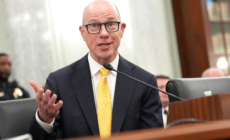-
Israel Kills Over a Dozen Seeking Food Aid in Gaza as Famine Fears Grow - 15 mins ago
-
E.U. Cuts Aid to Ukraine Over Corruption Concerns - 33 mins ago
-
BetMGM Bonus Code NW150: Claim $150 Bonus For Dodgers-Red Sox, MLB, WNBA - 50 mins ago
-
Drivers vs. Cyclists: A Battle for the Streets in Canada’s Largest City - about 1 hour ago
-
ICE holding Tunisian man without proper medical help, family says - about 1 hour ago
-
Did Giants’ QB Narrative Shift Russell Wilson’s Thinking? - about 1 hour ago
-
DraftKings Promo Code: Claim $150 Bonus For Dodgers-Red Sox, MLB, WNBA - 2 hours ago
-
How Hulk Hogan Leg-Dropped the Digital Media Industry - 2 hours ago
-
Emotional Kimi Antonelli Opens Up About Confidence Struggles At Belgian GP - 3 hours ago
-
A Clash Over a Promotion Puts Hegseth at Odds With His Generals - 3 hours ago
Rent Is More Affordable in 2025 Than It Has Been For Years
The income required for U.S. renters to afford the median apartment asking rent has dropped to its lowest level in three years, according to a report by Redfin.
An annual income of $63,680 was required to afford a median apartment rent of $1,592 in December 2024, the real estate brokerage company found.
This was down 0.4 percent from a year ago, and 6.4 percent from August 2022 when the median asking rent hit an all-time high of $1,700.
Newsweek has contacted Redfin for comment.

Getty Images
Why It Matters
Rental prices skyrocketed during the COVID pandemic, and they have not yet come back down to the levels seen before it. By the end of last year, rents were 20.9 percent above those seen five years ago, according to the Joint Center For Housing Studies at Harvard University. Rents have also risen faster than incomes across most regions of the country.
The affordability crisis is hitting low-income communities and households of color the worst, the U.S. Department of Treasury reported last year. As of 2024, almost 90 percent of families with an income below $20,000 spent more than 30 percent of their incomes on housing expenses—more than is considered sustainable.
What to Know
Redfin’s report revealed that the typical U.S. renter earns enough to afford the rent in 15 of the 44 major metropolitan areas that it analyzed. Its findings were based on an analysis of median U.S. apartment asking rents for the three months ending on December 31, 2024, and estimated median incomes for renter households.
The Texas cities of Austin, Dallas and Houston were the most affordable for renters. In Austin, renters earned a median salary of $69,781, 25.1 percent more than they needed to afford the typical apartment. Meanwhile in Dallas, they earned 10.3 percent more, and in Houston they earned 17.6 percent more.
The least affordable metros were Providence, Rhode Island, Miami, Florida, and New York City. In Providence, renters earned 41.25 percent less than they needed to rent a typical apartment. Meanwhile in Miami, they earned 39.78 percent less, and in New York City they earned 36.39 percent less.
The report also revealed that renting has become more affordable overall as renters are “earning more than ever.” The estimated median income for a renter in 2024 was $54,750, up 5.3 percent from 2023 when it was $52,019, and 35.2 percent from 2019 when it was $40,505.
“The gap between how much renters earn and the income they need to keep rent affordable is shrinking, with last month’s difference being the smallest in the five years Redfin has tracked the two metrics,” the report states.
However, the amount that renters earn is still 14 percent less than the income needed to afford the median monthly rent for an apartment in the U.S.
What People Are Saying
Sheharyar Bokhari, a senior economist at Redfin, said: “Rental affordability will continue improving this year, as wages grow and rents remain flat, thanks to the recent boom in apartment construction.
“The affordability gap between renting and buying is likely to widen further in 2025, as home prices rise and mortgage rates remain high. That means potential homebuyers—especially from younger generations—may decide to continue renting for longer, as it’s the only affordable option.”
Peyton Whitney, Research Analyst at the Joint Center For Housing Studies at Harvard University, wrote in a 2024 report: “Rents remain far above pre-pandemic levels across markets, and the relief from new construction that contained rent growth is likely to be short-lived due to recent declines in multifamily starts.
“In the future, these affordability issues will need to be addressed through increased rental subsidies, preserving the existing rental stock, and subsidizing construction targeted toward moderate- and lower-income households.”
What Happens Next
Americans are still expected to feel the squeeze of high housing costs this year. The continued affordability gap means potential homebuyers, in particular younger Americans, may decide to continue renting for longer.
Source link

















